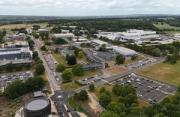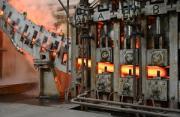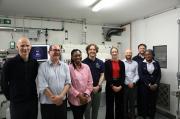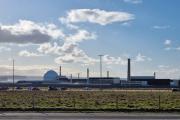Options Identified For Dealing With Particles In The Environment
5th November 2006
A panel of experts has identified a short-list of 11 feasible combinations of options for addressing the legacy of radioactive particles in the marine environment around Dounreay.
The options will be detailed for the first time tonight at the Environmental Research Institute in Thurso when Phil Cartwright (UKAEA) and Paul Dale (SEPA) will provide an update on the recent work undertaken to understand the extent of the contamination and the human health aspects respectively.
The panel recognised that recovering every particle was not possible and "an understanding of when the issue has been dealt with sufficiently" needs to be considered. The options therefore include differing degrees of clean-up of the seabed near Dounreay, from where particles buried in the sediment are carried by the sea onto nearby beaches.
Following public consultation earlier this year on the completeness of a list of options, revisions were made to the list and the assessment criteria. A total of 24 onshore and offshore options were identified.
In July, a scoring panel was established which included five independent members who provided expertise in health and safety, environmental, socio-economics, technical feasibility and regional issues. The scoring panel agreed the methodology for assessing the options and over an intensive three-day period assessed each onshore and offshore option separately. They then considered whether the options remaining could be combined to ensure an effective onshore and offshore option. The option combinations identified as feasible are:
Onshore monitoring with recovery plus offshore monitoring without recovery [current method]
Onshore monitoring with recovery plus offshore monitoring with recovery.
Onshore monitoring with recovery plus targeted recovery of detectable individual particles
Onshore monitoring with recovery plus recovering offshore particles by the targeted bulk removal of marine sediments.
Onshore recovery of all individual particles at all depths plus offshore monitoring with recovery.
Onshore recovery of all individual particles at all depths plus targeted recovery of detectable individual particles offshore.
Onshore recovery of all individual particles at all depths plus recovering offshore particles by the targeted bulk removal of marine sediments.
Onshore bulk removal of beach sediments plus targeted recovery of detectable individual particles offshore.
Onshore bulk removal of beach sediments plus recovering offshore particles by the targeted bulk removal of marine sediments.
Onshore restrict public access plus targeted recovery of detectable individual particles offshore.
Onshore restrict public access plus recovering offshore particles by the targeted bulk removal of marine sediments.
The detail of the options, as discussed by the panel, focus on monitoring the beaches and offshore areas local to Dounreay, including Sandside beach. Monitoring of local beaches outwith the local area will continue.
Full consultation with the public and stakeholders on the feasible combined options is now scheduled to take place in early 2007.
Phil Cartwright, Particles and Contaminated Land Manager, UKAEA said "UKAEA has taken a major step forward in identifying the long term management strategy for dealing with particles in the environment. We recognise this is of interest to a wide cross section of the community particularly those who have been most directly affected. We want to continue to consult to ensure we have everyone's views on a way forward which is both environmentally sound and publicly acceptable."
Geoffrey Minter, Sandside's proprietor, said: "Sandside is encouraged by what it regards as a constructive new attitude within the senior management of the UKAEA and Dounreay. It very much hopes that this more open and responsive approach will produce results soon and lead to a serious, long-term programme to return the local environment to its original pristine state. The publication of the BPEO Scoring panel result today is a step in the right direction. Like me, the Caithness public want to see a
professional clean up operation in the affected close vicinity of Dounreay. Action must be taken urgently to put this into effect. I stand ready to help in any way I can."
Particles were generated during the dismantling and preparation for reprocessing at Dounreay of spent nuclear fuel. There is evidence that some of these particles entered the drainage systems at Dounreay and were discharged to sea.
Lower activity particles have been detected and recovered during routine monitoring of the beaches used by the public at Sandside (70 particles) and Dunnet (1 particle). Higher activity particles have been detected on the foreshore at Dounreay and in the sediment offshore. Restrictions on fishing are in place in this area.
UKAEA is required to monitor a number of local beaches to criteria regulated by SEPA, when access is available to do so.
In March, SEPA published research into the potential health effects of particles typically found at Sandside. While there is potential for short-term visible effects to occur through skin contact, the chances of coming in to contact with a particle are extremely low.
See: http://www.sepa.org.uk/news/releases/view.asp?id=349&y=2006
The options have been identified as part of a study to determine if there is a better option to reduce the risk from particles than the current strategy of monitoring beaches.
See: http://www.ukaea.org.uk/sites/dounreay_particles.htm
Related Businesses
Related Articles
UKAEA develops 3D printing for fusion components
At its recently opened Central Support Facility (CSF), UKAEA has commissioned an electron beam additive manufacturing machine that can be used to incorporate tungsten into components, alongside a selective laser manufacturing machine. Fusion can play a key role in a global low carbon energy future.Advancing Fusion Remote Maintenance: Industry Collaboration Driving Innovation
As part of the Fusion Futures (FF) programme, UKAEA's Remote Applications in Challenging Environments (RACE) has partnered with industry leaders to develop two groundbreaking technologies for remote maintenance in fusion energy engineering. Thanks to FF funding, industry has taken the lead in maturing UKAEA technology concepts—delivering real-world solutions that enhance operational autonomy and reduce maintenance burdens in extreme environments.UKAEA launches International Fellowships Scheme for fusion
UKAEA has launched the International Fellowships Scheme, an initiative to help expand the global talent pool supporting the fusion industry. The scheme is part of the UKAEA's Fusion Opportunities in Skills, Training, Education and Research (FOSTER) Programme, which aims to train, support, and empower the next generation of professionals, who will help deliver fusion power to the grid.Kyoto Fusioneering and Astral Systems join Culham fusion hub
UKAEA's Culham Campus welcomes Kyoto Fusioneering and Astral Systems as its latest tenants. Two pioneering companies, Kyoto Fusioneering and Astral Systems, have joined the growing cluster of fusion technology and AI organisations at United Kingdom Atomic Energy Authority's (UKAEA) Culham Campus.
Fusion-grade Steel Produced At Scale In UK-first
Researchers achieve 10x production cost savings for reduced activation steel. A United Kingdom Atomic Energy Authority (UKAEA) working group has successfully demonstrated the industrial scale production of fusion-grade steel.
UKAEA To Lead The Creation Of A Robotics And AI Cluster
UKAEA will lead the creation of a new £4.9m nuclear robotics and artificial intelligence cluster across Cumbria and Oxfordshire. The robotics and AI cluster was announced by UK Research and Innovation (UKRI) as one of seven new projects to kickstart economic growth and address regional needs: www.ukri.org The robotics and AI cluster will link Cumbria and Oxfordshire to accelerate the decommissioning of the UK's legacy nuclear fission facilities and keep people out of hazardous environments.
Diamonds Are Forever? World-first Carbon-14 Diamond Battery Made In Uk
The world's first carbon-14 diamond has been produced with the potential to provide power for thousands of years. Scientists and engineers from the UK Atomic Energy Authority (UKAEA) and the University of Bristol have successfully created the world's first carbon-14 diamond battery.
UKAEA Monthly Newsletter Latest Edition
Find out what has been happening at UKAEA in our monthly newsletter. Read about our recent activities and upcoming events.
UKAEA Newsletter - Edition 11 Published Today
Find out what has been happening at UKAEA in our monthly newsletter. Read about our recent activities and upcoming events.
Corwm Visits Dounreay Nuclear Site
Members were given an overview of the scale of the problem and challenges faced in the decommissioning of the site. In the last week of March 2024, several members of CoRWM led by the Chair, Sir Nigel Thrift, made the long journey up to the North of Scotland to visit the Dounreay nuclear site, now managed by Nuclear Restoration Services.
